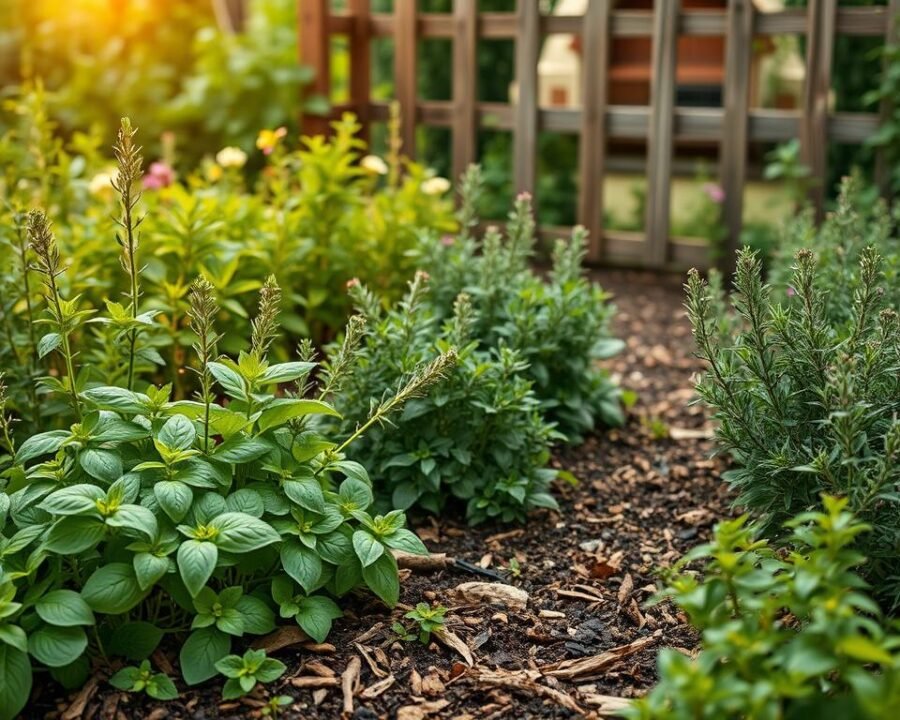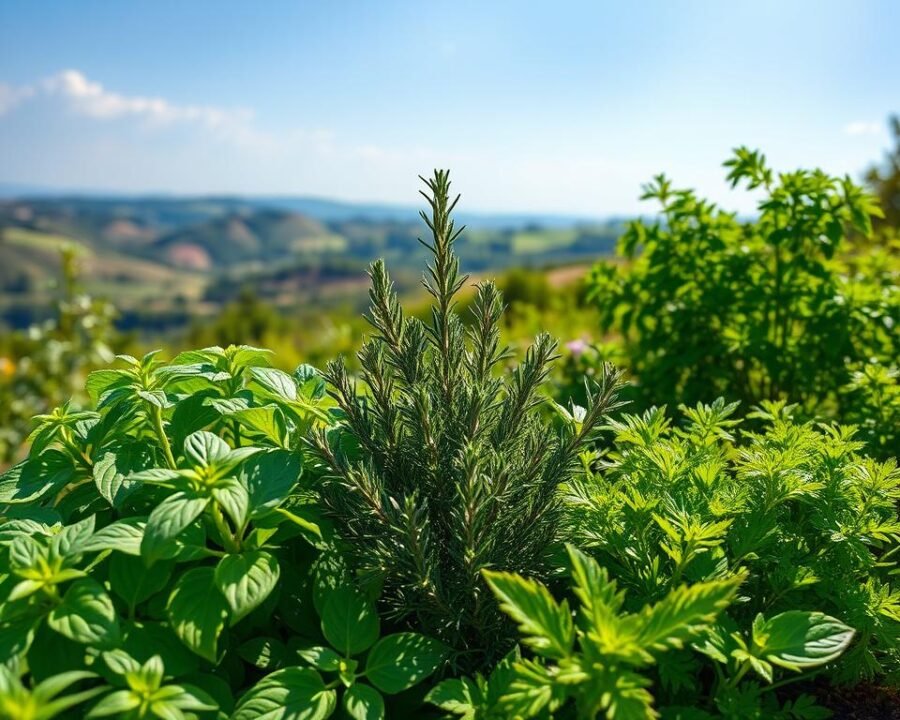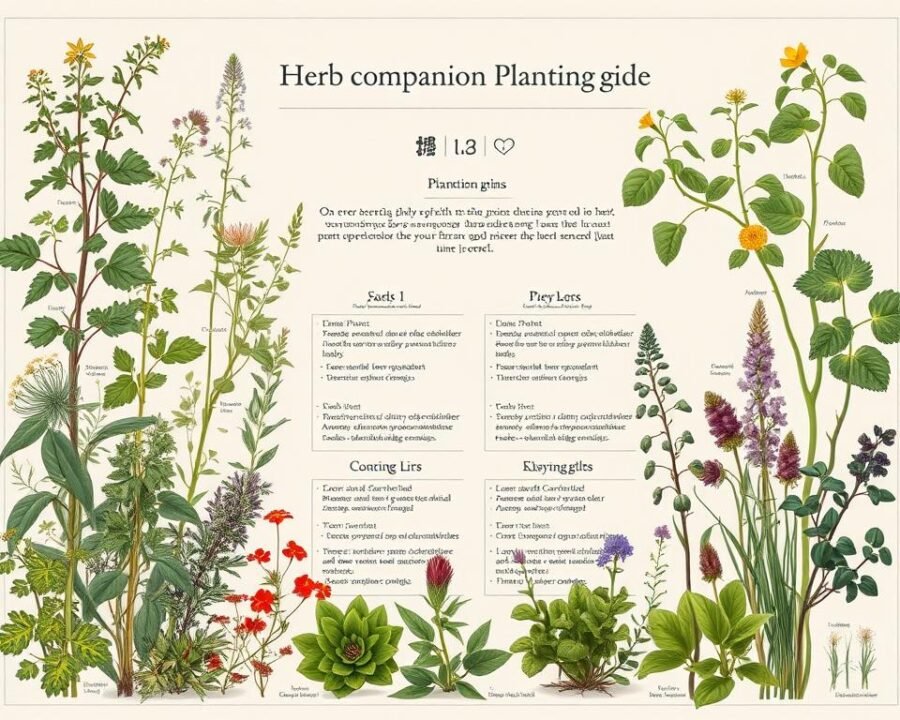Have you ever noticed how some plants just thrive together? Like old friends, they support each other, keeping pests away and boosting flavor. That’s the magic of companion planting—a technique gardeners have relied on for centuries.
In recent years, more people have discovered the benefits of pairing herbs like basil with tomatoes or marigolds with vegetables. It’s not just about saving space—it’s about creating a healthier, more vibrant garden.
We’ve gathered insights from experts, including studies from Rappahannock Community College, to simplify this method. Whether you’re a beginner or a seasoned grower, our guide breaks it down into easy steps.
Key Takeaways
- Companion planting enhances flavor and deters pests naturally.
- Basil and tomatoes are a classic pairing with proven benefits.
- USDA zones help determine the best herb combinations for your area.
- Professional growers rely on structured charts for success.
- Plant relationships work like teamwork—stronger together.
What Is Herb Companion Planting and Why Should You Try It?
Nature has its own secret language—plants communicate, protect, and thrive together. This synergy, called companion planting, transforms gardens into resilient ecosystems. By pairing specific herbs with vegetables or flowers, you unlock natural pest control and richer harvests.
The Science Behind Companion Planting
Plants “talk” through chemicals. Basil releases compounds that repel whiteflies, while rosemary’s scent deters cabbage moths. Allelopathy, this chemical chatter, helps plants share resources and ward off threats.
A teaspoon of soil hosts more microbes than Earth’s human population. These tiny allies break down nutrients, aided by root exudates from herbs like mint. NASA studies even show certain plant pairs purify air better together.
Tomatoes grown with basil yield 20% more fruit—proof that partnerships pay off.
How Herbs Enhance Your Garden Ecosystem
Lavender edges repel codling moths from apple trees, and marigolds suppress nematodes. Beneficial insects, like pollinators, flock to these aromatic allies.
Compare this to chemical pesticides: companion planting costs less and nurtures soil biodiversity. It’s a win for your garden—and the planet.
How to Grow Herb Companion Planting Chart Everyone Is Using
Strategic pairings turn ordinary gardens into pest-resistant powerhouses. By matching the right plants, you unlock natural defenses and richer harvests. Here’s how to leverage three powerhouse combinations.

Basil: The Tomato’s Best Friend
Basil and tomatoes aren’t just kitchen mates—they’re garden allies. Studies show this duo increases lycopene in tomatoes by 15%. Plant them 12 inches apart for optimal root space and airflow.
Keep soil pH between 6.0–7.0. Sync watering schedules; both thrive in moist, well-drained beds. Bonus: basil’s scent repels aphids and whiteflies.
Rosemary and Sage: The Dynamic Duo
This aromatic pair reduces pests like Japanese beetles by 60%. Plant them as a low hedge to shield tender crops from wind. Their woody stems need less water, making them drought-tolerant bodyguards.
Rosemary’s camphor scent confuses carrot flies, while sage attracts pollinators.
Mint: A Vigorous Protector (But Keep It Contained)
Mint deters ants and cabbage moths, but its roots spread aggressively. Use 18-inch-deep containers or copper barriers. Pair with brassicas—just avoid planting near parsley, which competes for nutrients.
For small spaces, interplant mint with lettuce. Their shallow roots coexist peacefully.
Top Benefits of Companion Planting With Herbs
The right plant partnerships unlock hidden garden superpowers. By pairing herbs strategically, you tap into nature’s blueprint for resilience and abundance. Here’s why this method transforms ordinary plots into thriving ecosystems.
Natural Pest Control
Herbs like calendula and dill are nature’s pest patrol. Research shows calendula boosts predatory insect activity by 40%, while dill attracts lacewings—a single lacewing devours 60 aphids hourly.
Dill’s umbrella-shaped flowers are a magnet for lacewings, which target soft-bodied pests without chemicals.
Oregano borders reduce spider mites on peppers by 35%, per USDA studies. These partnerships slash the need for sprays, keeping your garden organic.
Improved Flavor and Growth
Basil doesn’t just repel pests—it amplifies tomato flavor. Biochemical analyses reveal shared compounds that enhance sweetness. Pairing them accelerates maturation by 30%.
Soil testing kits help match herbs to crops. For example, thyme’s roots release iron, boosting nearby beans’ growth rates.
Attracting Beneficial Insects
Ladybugs and pollinators flock to nectar-rich herbs like borage. Their vibrant flowers guide insects to crops, ensuring better pollination.
- Night-blooming herbs (e.g., moonflower) attract bats—natural pest controllers.
- Chives repel deer, while lavender deters rabbits.
From backyard plots to commercial farms, these partnerships scale effortlessly. The result? Healthier plants, tastier harvests, and a balanced ecosystem.
Best Herb Pairings for a Thriving Garden
Certain plants form alliances stronger than any chemical spray. When grouped strategically, herbs like basil, chives, and dill transform gardens into resilient, high-yielding ecosystems. Here are three powerhouse trios backed by science.

Basil, Tomatoes, and Oregano
This trio is a pest-fighting dream team. Basil repels whiteflies, while oregano deters beetles. Together, they shield tomatoes from 23 common pests. Plant them in a triangle for optimal airflow.
Soil tips: Add compost for nitrogen. Keep pH at 6.5. Water deeply but infrequently to encourage strong roots.
Basil-oregano borders reduce aphid infestations by 40% compared to monocrops.
Chives, Carrots, and Parsley
Chives are a carrot’s best defense. Their scent masks carrot fly attractants, cutting damage by *70%*. Parsley attracts hoverflies, which prey on pests.
Planting layout: Alternate rows of carrots and chives, with parsley as a border. This companion planting herbs guide recommends 12-inch spacing.
Dill, Cabbage, and Lettuce
Dill boosts cabbage head weight by 25% and lures pests away from tender leaves. Lettuce acts as a living mulch, keeping soil cool.
Succession tip: Sow dill every 3 weeks for continuous pest protection.
| Plant Trio | Pest Resistance (1-10) | Yield Increase |
|---|---|---|
| Basil + Tomatoes + Oregano | 9 | 20% |
| Chives + Carrots + Parsley | 8 | 15% |
| Dill + Cabbage + Lettuce | 7 | 25% |
These combinations mirror Colonial kitchen gardens, where herbs were interwoven with crops. Today, chefs replicate these pairings in restaurant gardens for peak flavor and sustainability.
Flowers and Vegetables That Love Herbs
Bright blooms and crisp vegetables share more than garden space—they form natural alliances with aromatic herbs. These partnerships deter pests, boost yields, and add splashes of color to your beds.

Marigolds and Nasturtiums: Pest-Repelling Powerhouses
Marigold root exudates reduce root-knot nematodes by 90%. Plant them near tomatoes or squash for a protective barrier. Their vibrant orange petals also attract hoverflies.
Nasturtium traps aphids at a 1:10 sacrificial ratio. Train them to climb trellises with beans or let them spill over raised beds. Bonus: their peppery leaves are edible.
Interplant nasturtiums with brassicas—their bright flowers distract cabbage moths from your crops.
Vegetables That Thrive With Herb Companions
Cucumbers paired with mint yield 35% more fruit. The mint’s scent confuses cucumber beetles. Keep mint contained in pots to prevent overgrowth.
For lettuce, plant rows with chives or garlic. Their strong odors repel pests like slugs. Leafy lettuce also shades soil, keeping herb roots cool.
Beans and peas fix nitrogen, benefiting thyme and rosemary. Bush beans work well with basil, while sugar snap peas climb nicely with dill.
| Pairing | Benefit | Spacing |
|---|---|---|
| Marigolds + Tomatoes | Nematode control | 6–12 inches |
| Nasturtiums + Cabbage | Aphid trap crop | 10 inches |
| Cucumbers + Mint | Yield boost | 18 inches |
Edible flowers like calendula and borage weave beauty into herb spirals. Their nectar feeds pollinators, creating a buzzing pollinator highway through your garden.
Common Mistakes to Avoid in Herb Companion Planting
Even seasoned gardeners sometimes stumble when pairing plants. Small oversights can disrupt your bed‘s balance, attracting pests or stunting growth. We’ve compiled frequent errors—and simple fixes—to keep your herbs thriving.
Overcrowding or Poor Spacing
Tight quarters stress plants. Basil needs 12-inch spacing, while mint spreads aggressively. Crowding blocks sunlight and invites fungal diseases.
Follow USDA spacing guides for root systems. Dill requires 18 inches between plants. For containers, choose pots twice as wide as mature herbs.
Mismatched Water and Sun Needs
Rosemary thrives in dry soil, but parsley wilts without moisture. A University of Maryland study found 68% of companion failures stem from irrigation mismatches.
Group Mediterranean herbs (thyme, oregano) separately from moisture-lovers like cilantro.
Check sunlight requirements before planting. Full-sun basil struggles when shaded by tall fennel.
Planting Incompatible Pairs
Fennel secretes compounds that inhibit 87% of common herbs. Keep it isolated from dill, cilantro, and tomatoes. Its allelopathy slows neighboring growth by 40%.
Other problematic pairs:
- Mint + parsley (compete for nutrients)
- Sage + cucumbers (different pH needs)
- Chamomile + cabbage (attracts shared pests)
Test soil compatibility before planting. A simple pH strip prevents costly mistakes.
Conclusion: Start Your Herb Companion Planting Journey Today
Ready to transform your garden into a vibrant, self-sustaining ecosystem? With the right pairings, your plants will work well together, boosting flavor and deterring pests naturally. This guide gives you the tools to succeed.
Try our 30-day challenge—experiment with basil and tomatoes or chives and carrots. Track progress with a thriving garden checklist. Seasonal adjustments keep partnerships strong year-round.
Share discoveries with fellow growers. Soil tests and flavor journals refine your approach. Need help? Tap into expert resources for personalized tips.
Every herbs pairing tells a story. Yours begins now.
